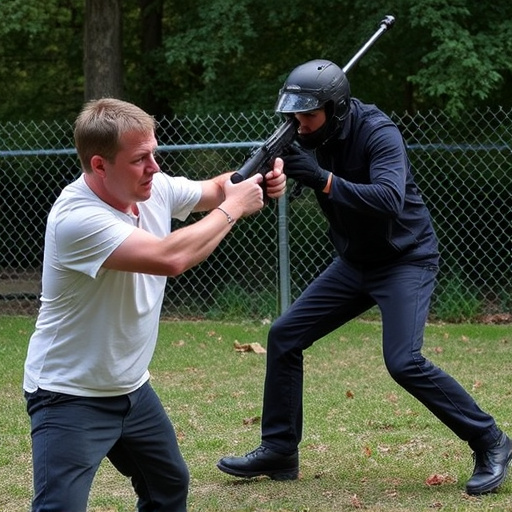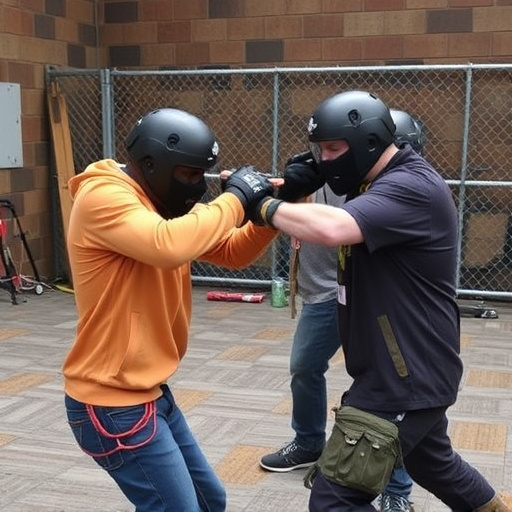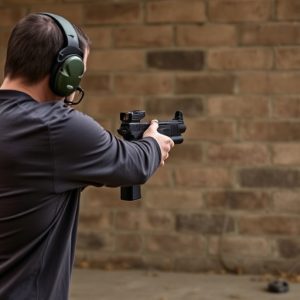Stun Gun Amperage: Risks & Safety for Pacemaker Wearers
Pacemakers, vital for maintaining heart rhythm, are susceptible to harm from stun guns' high-vo…….
Pacemakers, vital for maintaining heart rhythm, are susceptible to harm from stun guns' high-voltage, low-amperage electrical pulses. These electromagnetic signals can trigger pacemaker response mechanisms, delivering unsafe shocks or causing failure. Individuals with pacemakers should avoid stun guns and take precautions, as documented cases of interference have led to serious health effects, including temporary signal disruptions and severe heart rhythm irregularities. Awareness and safe practices are crucial in law enforcement and self-defense scenarios to prevent accidental harm from stun gun deployment near pacemakers.
Electrical shock weapons, like stun guns, operate by delivering a high-voltage, low-amperage electric pulse. While their effectiveness is well documented, their impact on individuals with pacemakers poses significant risks due to the sensitivity of these devices to electrical signals. This article delves into the intricate details of pacemaker interference with stun guns, exploring how stun guns function, the amperage they produce, and the potential consequences for pacemaker recipients. We also present real-world case studies and offer crucial safety precautions for using stun guns near these life-saving devices.
- Understanding Pacemakers and Their Sensitivity to Electrical Signals
- How Stun Guns Work and the Amperage They Produce
- The Impact of Stun Gun Amperage on Pacemaker Functionality
- Case Studies: Real-World Examples of Pacemaker Interference
- Safety Precautions and Recommendations for Using Stun Guns Near Pacemakers
Understanding Pacemakers and Their Sensitivity to Electrical Signals

Pacemakers, a vital medical device for millions worldwide, are designed to regulate heart rhythm by delivering electrical impulses to the heart muscle. However, this sensitivity to precise electrical signals makes them susceptible to interference from external sources, including certain types of electrical shock weapons. Stun guns, for instance, emit high-voltage, low-amperage electrical pulses that can potentially disrupt pacemaker function, leading to dangerous consequences.
The issue arises because stun guns operate within a voltage range that might trigger the pacemaker’s response mechanism, causing it to deliver an inappropriate electrical impulse to the heart. This interference can result in temporary or permanent damage to the pacemaker, even causing it to stop working altogether. Therefore, individuals with pacemakers are generally advised to avoid proximity to stun guns and similar devices, ensuring safety measures are taken to prevent any potential harm.
How Stun Guns Work and the Amperage They Produce

The Impact of Stun Gun Amperage on Pacemaker Functionality

Stun guns, despite their name, do not rely on electricity to stun a target; instead, they discharge high-voltage, low-amperage electrical pulses. However, this very feature can pose a significant risk to individuals with pacemakers, as these devices are highly sensitive to electrical signals. The amperage of a stun gun, typically ranging from 20,000 to 50,000 volts, could potentially interfere with pacemaker functionality. Even brief exposure to such high voltage can cause the pacemaker to deliver inappropriate shocks or cease functioning altogether, leading to dangerous consequences for the wearer.
Pacemaker interference with stun guns is a critical consideration, especially in law enforcement and self-defense scenarios where both officers and civilians might carry these devices. To mitigate this risk, individuals with pacemakers are advised to inform themselves and others about the potential dangers and take precautions when using or encountering stun guns. Additionally, ensuring that stun guns are stored safely and away from accessible areas for those with pacemakers can help prevent accidental exposure to high-amperage electrical pulses.
Case Studies: Real-World Examples of Pacemaker Interference

In real-world scenarios, the impact of stun guns on pacemakers has been a significant concern, leading to several case studies and discussions in medical and legal circles. Pacemaker interference with stun guns is a critical issue as stun devices, designed to deliver electric shocks for immobilization, can potentially interfere with the proper functioning of these life-saving heart rhythm management devices.
Numerous instances have been documented where individuals with pacemakers have experienced adverse effects when exposed to stun guns. These cases range from temporary disruptions in pacemaker signals to more severe consequences, such as irregular heart rhythms or even complete pacemaker failure. For example, a study published in the Journal of Interventional Cardiology highlighted a case where a subject’s pacemaker stopped functioning temporarily after being zapped by a stun gun during an arrest simulation. Such incidents underscore the need for awareness and precautions when using stun guns in close proximity to individuals with pacemakers.
Safety Precautions and Recommendations for Using Stun Guns Near Pacemakers

Using stun guns near pacemakers presents unique safety concerns due to the potential for interference. Pacemakers rely on precise electrical signals to regulate heartbeats, and any disruption can cause serious health issues, including irregular heartbeat or even failure of the device. When a stun gun emits its high-voltage electric charge, it can interfere with these signals, leading to unpredictable pacemaker behavior.
To mitigate this risk, users should maintain a safe distance between their bodies and any individuals with pacemakers before deploying a stun gun. Following manufacturer guidelines regarding use and range is crucial. Additionally, individuals with known heart conditions or those carrying pacemakers should consult with healthcare professionals for personalized advice on using stun guns to ensure safety and prevent potential complications.
In conclusion, while stun guns offer personal safety benefits, their high amperage can pose significant risks to individuals with pacemakers, leading to potentially dangerous pacemaker interference. Understanding the impact of electrical signals on these devices is crucial for both users and medical professionals. By being aware of the dangers and implementing safety precautions, it’s possible to minimize the chances of pacemaker malfunction during stun gun use, ensuring a safer environment for all.


